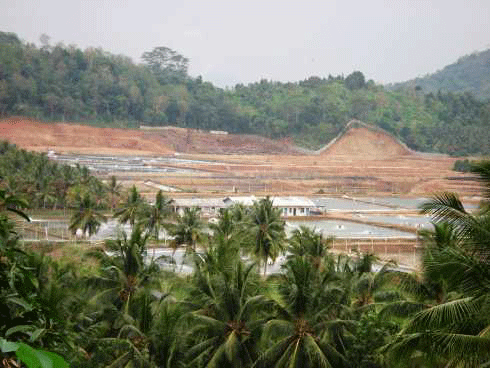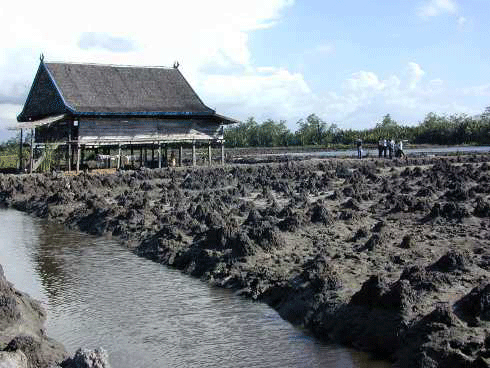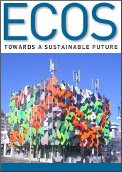
|
Published: 8 August 2011
Managing aquaculture’s net benefits
Fish and shrimp farming is one of the world’s fastest growing food production sectors. While aquaculture has clear benefits, including alleviating high pressure on wild fish stocks, its recently assessed development trajectory and potential environmental impacts are still raising concern. Fortunately, nearly thirty years of leading research into more sustainable aquaculture by Australian scientists is set to benefit the industry in the Oceanic region.
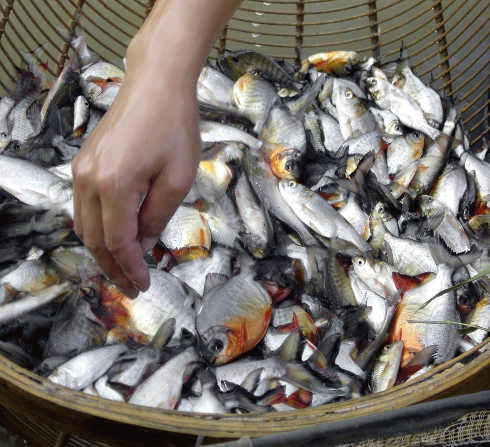
|
|
Haul from a pond in Xi Shuang Banna, Yunnan Province, China. Credit: Francis Murray
|
The rapid growth of aquaculture over the past four decades – an average of 8.4 per cent annually – is part of a larger story: humanity’s growing demand for animal protein. This demand is driven partly by population growth, but mainly by rising standards of living and prosperity in developing countries.
Blue Frontiers: Managing the environmental costs of aquaculture is a global report on aquaculture intensity and its projected demand for biophysical resources.
Published in June 2011 by Conservation International and the World Fish Centre, the analysis shows that countries with the most rapid annual growth rates are China, the rest of Asia, and South America (6, 11.2 and 7.8 per cent respectively), with Africa showing explosive growth (16.2 per cent), albeit from a very low baseline. These are countries with rising standards of living – and hence rising protein demand. The growth in farmed fish supply, however, appears to have significantly outpaced growth in world population.
As aquaculture has expanded, the report says, so too have its environmental impacts. These fall into two broad categories: impacts from nutrient emission (from feed waste, fish faeces and fertiliser inputs) to water, air and soil; and impacts from depletion of wild fish stocks, which are used to feed carnivorous and omnivorous farmed fish.
Other concerns include carbon dioxide emissions from fossil fuel use, and food security concerns associated with land-use changes.
Like any farming, aquaculture comes in many forms, based on regional parameters: tanks, ponds, marine or freshwater cages, and intensive (high-input, technologically sophisticated) versus extensive (broader, using more natural water systems), or semi-intensive systems.
As with terrestrial farming, the trend is towards intensification. The Blue Frontiers report noted that ‘there are tradeoffs between extensive systems that place higher demands on land use, and ecological services such as water, fuel, nutrient cycling, and intensive systems that require higher levels of fossil fuels and feed, and produce more effluent.’
The impacts of protein production
Comparisons of the environmental impact of different forms of animal farming for protein are often made in terms of the ‘feed conversion ratio’: the proportion of food eaten by the animal that is turned into body mass. The lower the ratio (e.g. 1.5:1 v. 30:1), the lower the environmental impact, because fewer resources must be consumed to produce the same amount of mass.
From this perspective, fish fare well. As Dr Brett Glencross, a leading aquaculture researcher at CSIRO’s Marine and Atmospheric Research division explains, ‘it takes ~1.3 kg of feed to produce 1 kg (edible weight) of salmon, compared to ~30 kg of feed to produce 1 kg (edible weight) of beef. Moreover, 60 per cent of salmon body mass is edible, compared to only 33 per cent for a meat cow.’
The feed conversion ratios of farmed fish differ between species. Commonly farmed carnivorous finfish such as salmonids, sea bass, sea bream, eels and amberjack, have the highest dietary protein requirements but the lowest feed conversion ratios among farmed fish species. These are grown throughout the world (Europe, Asia, North and South America and Australia) in large cage systems.
Australia has a small but developing industry, which includes Atlantic salmon farmed in cages off the Tasmanian coastline (supplying ~1.5 per cent of the world’s overall salmon production), and the fattening of young, wild-caught southern blue fin tuna (known as ‘tuna ranching’) in the Spencer Gulf off the South Australian coast.
According to Tooni Mahto, a marine biologist with the Australian Marine Conservation Society, ‘the feed conversion ratio for tuna ranching is roughly 12: 1 (kg feed/kg live weight)’. This ratio is so high that it approaches the conversion ratio for beef, given in the Blue Frontiers report as 12.7:1 (kg feed/kg live weight).
Like high-value salmon and trout aquaculture, cultured crustaceans, such as shrimp or prawns, have relatively high dietary protein requirements (between 30 and 40 per cent of feed) and, therefore, corresponding demand for wild fish feed components.
By contrast, farmed shellfish (e.g. mussels, oysters, scallops, and clams) make no demands on wild fish stock by filter feeding, and may actually reducing excessive nutrient loads in the water.
Asia, which now produces 91 per cent of total global aquaculture production (China being responsible for 61.5 per cent), cultures mostly omnivorous fish (tilapias, milkfish, common carp and catfish), with some production of herbivorous species. These tend to rely on lower (< 30 per cent) protein contents in their diets.
The Blue Frontiers report notes significant growth in crustacean aquaculture in Asia of ~53 per cent between 2003 and 2008.
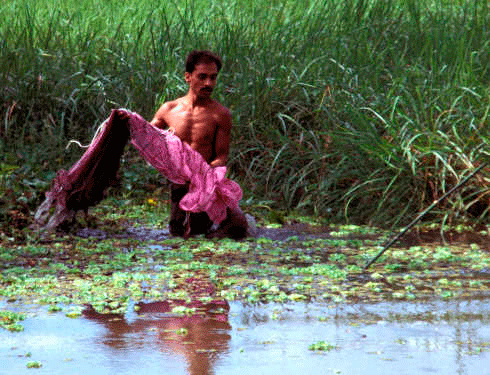
|
|
Netting small fish in a natural aquaculture system, Bangladesh. Credit: Mark Prein
|
Reducing demands on wild-caught feed
Dr Glencross explains that the main sources of the fish component of feed for aquaculture, including in Australia, are ‘feed fisheries’ off the west coast of South America. Feedfish are anchovies and other low-value species which are processed into a practical dried fishmeal product with a longer shelf life than raw or frozen fish.
A recent report on the use of fish as feed inputs for aquaculture, produced by the United Nations Food and Agriculture Organisation (FAO), notes that the short lifecycle of these feedfish usually enables their quick recovery from high levels of exploitation. But, the report also identifies that ‘their survival is also dependent on extrinsic climate-related factors that make them vulnerable to overfishing’.
Meanwhile, Tooni Mahto says the Australian Marine Conservation Society cautions that the consequences for the wider ecosystem of human-induced variability in these pelagic feedfish (including natural predators) are not fully understood.
But, Dr Glencross points out that the major feed fisheries are subject to strict quotas.
‘We’ve known for over twenty years that the total sustainable annual harvest from those fisheries is in the order of 30 million tonnes, and this gets turned into roughly 7 million tonnes of animal feed [fed not only to fish, but also to other livestock including pigs and poultry]: 6 million tonnes of fishmeal and 1 million tonnes of fish oil.
‘There has been a lot of work done on the management of those fisheries. They are generally regarded as sustainably managed.’
According to Dr Glencross, despite the small size of its aquaculture industry, Australia leads the world in minimising the proportion of fish in the diets of not only high-value cultured finfish, but also farmed prawns.
‘A lot of the work that I’ve been doing with CSIRO over the last 10 to 20 years involved looking at what other protein sources can we draw on to reduce our reliance on feed fisheries and hence reduce our risk exposure, keeping in mind that over the past ten years the price of fishmeal has more than trebled.
‘Australian research has reduced the fishmeal content of locally grown salmon diets down to 10 per cent. And, this is achieved without affecting the growth performance or health of the animal. In Europe or Canada they are using substantially more; 20 per cent and upwards, in terms of fishmeal as a proportion of salmon diet.’
Amino acid (protein) sources for these new fish feed formulations include a range of grain products, such as lupins, canola meal, wheat and wheat processing by-products such as glutens.
This research has been complemented by work on refining feeding regimes. ‘When the fish are small and growing really fast, we feed them formulations that contain a higher proportion of protein,’ says Dr Glencross.
‘Because the fish are smaller, the feed volumes are smaller, and you can afford to pay a premium for their diets. This is where most fishmeal is now being directed, so you get extra value from the resource but minimise demands on the volume required.
‘Then, as fish mature and the volume of feed they require increases exponentially, you transition them to diets increasingly reliant on alternative proteins, like vegetable-based diets, which are also cheaper due to the lower fishmeal content.’
The Blue Frontiers report highlights that the bulk of fishmeal imported into Asia is now used in crustacean aquaculture. Dr Glencross says that fishmeal inclusion in shrimp aquaculture is of the order of 10–20 per cent, and it uses less fish oil than salmon and barramundi farming. But the scale and volume of shrimp farming still means that it uses a significant proportion of the catch from fishfeed fisheries.
Leading research helps ease regional pressures
Associate Professor Jes Sammut of the University of New South Wales has been involved in extension programs in South-East Asia, helping small-scale shrimp farmers reduce their environmental impacts and improve their productivity.
‘Quite a lot of shrimp farmers used to be rice farmers who were attracted to the potentially higher income from farming shrimp,’ he says.
‘But, often the land is good for rice but not for aquaculture. Once the farmers converted the rice farms over to aquaculture, they couldn’t then convert them back, because they’d changed the soil and hydrology.’
The local shrimp farming is brackish water aquaculture. Assoc. Prof. Sammut says it involves ‘bringing tidal waters into the landscape to establish ponds’, and is typically more intensive than traditional agricultural enterprises in terms of infrastructure requirements, fossil fuel and feed inputs.
He explains, the ‘brackish water aquaculture can affect groundwater and the salt can sometimes inundate nearby rice farms, often located in the same low-lying coastal areas.’ In addition, many of the soils that originally used to grow rice become ‘acid sulfate’ soils when excavated to form the dykes for ponds.
‘Farmers might get one or two crops and then the system crashes from the effects of soil acidity,’ says Assoc. Prof. Sammut. ‘We worked with farmers on simple techniques to assess land suitability, make choices about scale of development, and assess other perhaps more suitable agricultural alternatives.'
He also highlights, that intensification of aquaculture in developing regions needs more fossil fuel use, and tends to bring with it increased disease risk and chemical use, including antibiotics.
Many farmers have abandoned traditional integrated farming systems (e.g. systems that grow shrimp, seaweed and fish together) which, while not making them rich, may have been more ecologically stable and provided low-level income security and food security.
According to Dr Glencross, the South-East Asian region is now poised to take advantage of Australian aquaculture research. ‘As the most advanced technology provider in the Asia Pacific region, Australia is in a unique position as far as aquaculture research application goes,’ he says.
‘We are leading the charge in terms of shrimp genetics and shrimp nutrition. The Americans and Europeans have little interest in this area, because it’s not part of their industry.
‘We’re at a point now in Australia where we are seeing the fruits of the past 10 to 20 years’ research coming home to roost. CSIRO is so far ahead of the game that we are now applying for a patent on a technology that allows us to have zero fishmeal content in shrimp feed.’
Both the Blue Frontiers and FAO reports raise concerns that aquaculture industry growth, structural change and fish feed demand may aggravate food insecurity in the developing world. Would using low-value/trash fish as food for poor domestic consumers be more appropriate than supplying fishmeal plants for an export income-oriented aquaculture industry producing high-value commodities?
The opposing argument, as put by the FAO report, is that ‘food security may also be increased by improving the income generation capabilities of poor people, and that a large number of people employed in both fishing and aquaculture has a beneficial effect via income generation rather than direct food supply.’
Dr Glencross says that ‘while there have been efforts to divert some of the South American feed fishery fish to the human food chain, the economic imperatives have not been there to use the resource in this way’.
‘If the price per landed tonne were to rise enough from the current 10 cents per kilo to, say, 13 cents per kilo, this might start to happen. But, the reality is people don’t want to eat these products.’
The associated social and cultural effects of changes in aquaculture play out not only on the global scale, but also locally. As Assoc. Prof. Sammut explains, the lure of high returns from shrimp farming in South-East Asia has encouraged urban entrepreneurs to buy up land formerly farmed by locals on a subsistence and local market basis. This has turned small-scale landowning farmers into landless agricultural workers, altering the social structures of rural communities.
So, with firm predictions that aquaculture will continue its global growth to meet rising protein demand, collaborative Australian and international research will be fundamental to mitigating the industry’s environmental, social, and economic impacts while broadening its benefits.
More information
Blue Frontiers: Managing the environmental costs of aquaculture, The World Fish Centre, Penang, Malaysia, http://tiny.cc/m85ii
Fish as feed inputs for aquaculture: practices, sustainability and implications, FAO Fisheries and Aquaculture Technical Paper, http://tiny.cc/ynec2
Growing Australian aquaculture, http://www.csiro.au/science/psrv.html#2


